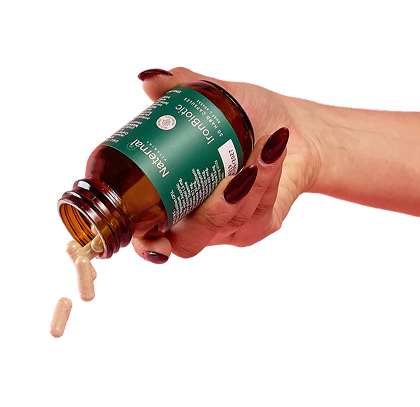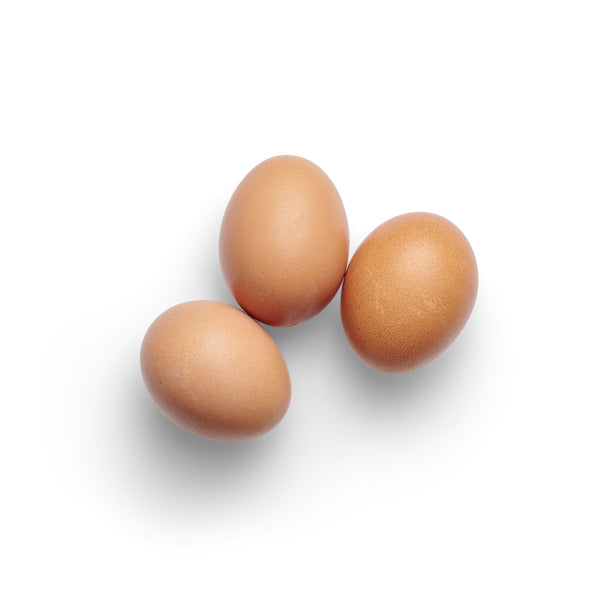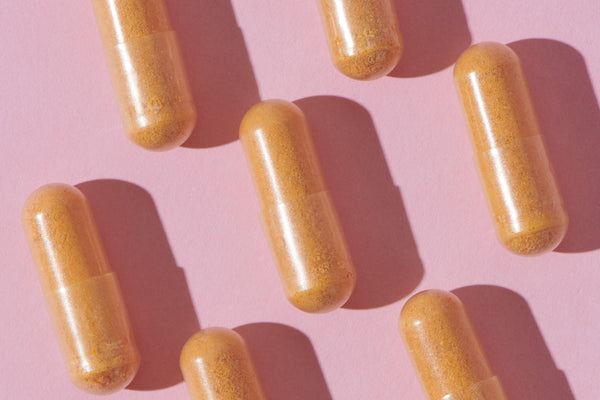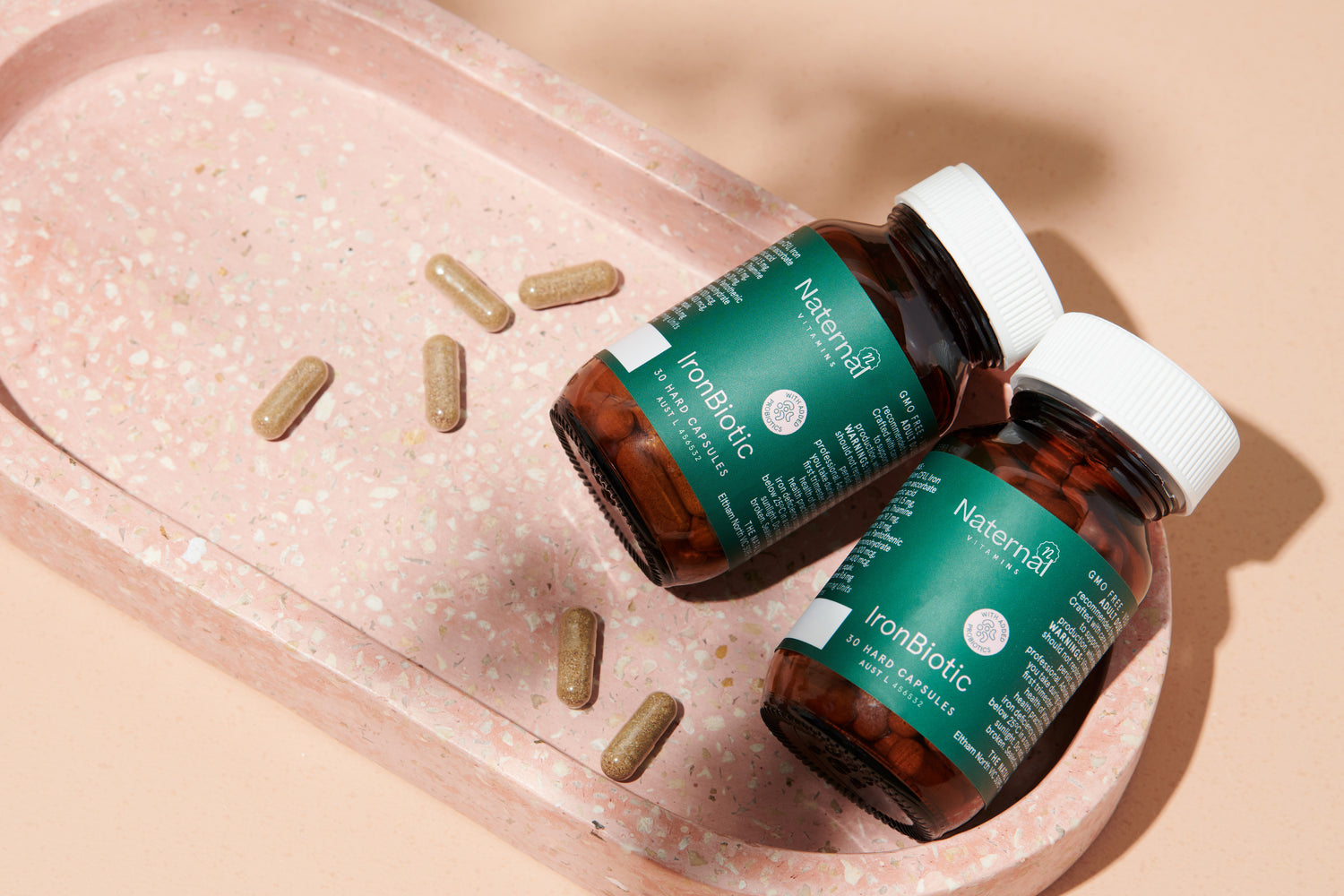Jump to:
When we talk about boosting iron levels, many people immediately think of taking more iron pills or eating more red meat. But the story is more nuanced. How well your body actually absorbs iron depends a lot on your gut... specifically, the state of your digestive system and its microbial community. Pairing iron with certain probiotics may enhance absorption, reduce side effects, and support overall digestive health.
Here’s why gut health and iron go hand in hand and how IronBiotic was developed to take advantage of that synergy.
The challenge of iron absorption
Iron is an essential micronutrient: it helps produce red blood cells, carry oxygen, support energy metabolism, and plays roles in immune function, among many other things. Yet iron deficiency (or low iron stores) is one of the most common nutrient shortfalls globally.
But having plenty of iron in your diet doesn’t guarantee that your body will absorb all of it. Absorption efficiency is influenced by:
-
Form of iron: Heme iron (from animal sources) is more readily absorbed than non-heme forms (from plants or supplements).
-
Dietary inhibitors & enhancers: Compounds like phytates (in grains, legumes), polyphenols (tea, coffee), calcium, and some minerals can inhibit iron absorption. Conversely, vitamin C enhances it by reducing ferric iron (Fe³⁺) to the more absorbable ferrous form (Fe²⁺).
-
Gastric acidity & transit: Proper acid levels in the stomach, healthy digestion, and normal transit time all help iron solubilise and reach the small intestine for uptake.
-
Systemic regulation (hepcidin): The hormone hepcidin regulates iron absorption by controlling whether iron can be released from intestinal cells into circulation. Inflammatory states often raise hepcidin, which reduces absorption.
-
Gut microbiome & intestinal health: This is the piece often underappreciated — the microbial ecosystem in your gut both influences and is influenced by iron supply and absorption.
In short: if your gut is imbalanced, inflamed, or dysfunctional, even a great iron supplement may not get you very far.
How the gut microbiome influences iron absorption
The gut microbiome isn’t just a bystander; it plays active roles in digestion, metabolite production, immune regulation — and micronutrient absorption. Here's how gut health can affect iron dynamics:
-
Competing microbes & iron scavenging
Many microbes require iron, too. If you have dysbiosis (imbalanced microbiota), there can be increased microbial competition or overgrowth of bacteria that sequestrate iron or alter its chemistry. -
Redox transformations & conversion to absorbable form
Some beneficial bacteria can reduce Fe³⁺ to Fe²⁺, making iron more bioavailable. This is a key chemical step for non-heme iron to be absorbed by enterocytes (intestinal cells). IPA Biotics+2Invivo Healthcare+2 -
Short-chain fatty acids (SCFAs) & improved environment
Probiotics and fiber feed bacteria that produce SCFAs like butyrate. These compounds help maintain intestinal integrity, reduce inflammation, and may help modulate pH or microenvironment to favour nutrient absorption. Invivo Healthcare+2BioMed Central+2 -
Reduced inflammation & improved barrier
A “leaky” gut or low-grade inflammation impairs nutrient absorption. Good microbial balance supports barrier function, lowers gut inflammation, and possibly reduces hepcidin activation caused by systemic inflammation. The Real Gut Doctor+3IPA Biotics+3MDPI+3 -
Avoiding adverse effects of iron on microbiota
Iron supplements, especially in higher doses, can change the gut microbial composition — sometimes favouring more pathogenic bacteria and suppressing beneficial ones, which can worsen gut health if left unchecked. MDPI+2Invivo Healthcare+2
Thus, a “gut-first” approach can help iron delivered via supplements or diet be better used, with fewer side effects.
Evidence: can probiotics actually help iron status?
The idea of combining probiotics with iron isn’t just theoretical. Some research supports that certain probiotic or prebiotic interventions can modestly improve iron absorption or iron storage markers — although the data are mixed and more studies are needed.
-
A 2025 meta-analysis found that in women of reproductive age, probiotics and/or prebiotics (with or without added iron) were associated with a small increase in fractional iron absorption (mean ~0.74 %) and a modest increase in ferritin levels (mean +2.45 ng/mL) compared to control groups. BioMed Central
-
The authors cautioned that evidence is low to moderate in certainty, and that effects on hemoglobin were not consistently observed. BioMed Central
-
The International Probiotics Organization notes mechanisms by which probiotics may support iron homeostasis: by reducing iron-binding compounds, converting iron to absorbable forms, and modulating immunity/inflammation. IPA Biotics
-
Some trials with Lactiplantibacillus plantarum (LP299v) have shown enhanced non-heme iron absorption in humans. Activated Probiotics+2IPA Biotics+2
-
That said, not all probiotic strains show benefit, and results depend heavily on the strain, dose, iron dose, population, and baseline iron status. IPA Biotics+2BioMed Central+2
In short: probiotics are promising as a complementary strategy, but they are not a substitute for well-designed iron supplementation when deficiency is present. Always consider clinical testing, context, and guidance from health professionals.
Meet IronBiotic — the gut-friendly iron support
At Naternal Vitamins, IronBiotic is formulated to harness the synergy of iron plus probiotics to support iron levels and gut health.
Key features of IronBiotic:
-
Iron bisglycinate: a chelated form of iron that tends to be better absorbed and more tolerable (less gastrointestinal distress) than conventional forms like ferrous sulfate or ferrous fumarate.
-
Probiotic strain: includes Bifidobacterium longum, chosen to support bowel regularity and gut flora balance. According to the product page, B. longum has been shown in trials to improve stool frequency and consistency in adults with constipation.
-
Additional supportive nutrients: includes activated B-vitamins (MTHFR-friendly), copper, and beta carotene, which help support iron metabolism and antioxidant balance.
-
Gentle on the gut: the chelated iron plus probiotic aim to reduce common side effects of iron (e.g. constipation, stomach upset) often experienced with standard iron supplements.
-
Vegan & allergen-free: no animal products, no gluten, soy, artificial colours, or preservatives.
By combining a bioavailable iron form with a probiotic, IronBiotic seeks to enable better absorption, reduce negative gut effects, and support the microbiome simultaneously.
Tips to get the most from Iron + Probiotics
If you or your audience are considering combining iron and probiotic interventions (or using a product like IronBiotic), here are some practical tips:
-
Check your iron status first: Always use blood tests (ferritin, hemoglobin, iron studies, CRP) to guide whether supplementation is needed and how aggressively to dose.
-
Choose the right probiotic strain(s): Not all probiotics help iron absorption. Strains like Lactiplantibacillus plantarum have more evidence; Bifidobacteria and others may offer indirect support via gut health.
-
Timing matters: Some sources suggest spacing iron and probiotic doses (e.g. 1–2 hours apart) to minimise potentially antagonistic interactions. wholeisticliving.com+1
-
Pair with vitamin C: Taking iron with 100–200 mg vitamin C (or with vitamin C–rich foods like citrus) can boost absorption by reducing Fe³⁺ to Fe²⁺.
-
Avoid inhibitors close by: Don’t take iron (or the supplement) with calcium, high-phytate foods (whole grains, legumes), tea, coffee, or polyphenol-rich beverages within an hour.
-
Lower doses more frequently: Sometimes smaller, divided doses cause fewer GI issues and may have better absorption than large single doses.
-
Support gut health broadly: Prebiotic fibre, polyphenols, fermented foods, avoiding unnecessary antibiotics, and managing stress/sleep can all enhance your microbiome’s capacity to help with iron.
-
Monitor and adjust: Re-test iron status after 8–12 weeks and adjust supplementation or timing accordingly.
Conclusion
Iron deficiency and poor iron absorption remain widespread concerns, but treating it isn’t just about dumping high doses of iron into your system. The gut — particularly its microbial community — plays an essential role in determining how much of that iron actually makes it into your bloodstream. By supporting the microbiome with probiotics (and gut-friendly practices), you can tilt the odds in your favour: better absorption, fewer side effects, and more sustainable iron balance.
IronBiotic is a thoughtfully designed formula that pairs a well-absorbed iron bisglycinate with a probiotic strain (and supporting nutrients) to honour that synergy. For many people, it may offer a gentler, smarter way to support iron levels while nurturing gut health.






